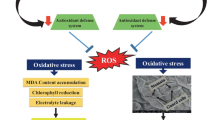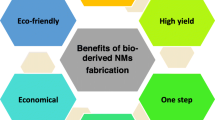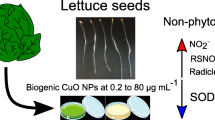Abstract
Plant growth regulators tagged on metallic oxide nanoparticles (NPs) may function as nanofertilizers with reduced toxicity of NPs. CuO NPs were synthesized to function as nanocarriers of Indole-3-acetic acid (IAA). Powder X-ray diffraction (XRD) and scanning electron microscopy (SEM) revealed 30.4 nm size of NPs and sheet-like structure, respectively, of CuO-IAA NPs. Fourier-transform infrared spectroscopy (FTIR) confirmed CuO-IAA formation. IAA-decorated CuO NPs enhanced the physiological parameters of Chickpea plants, i.e., root length, shoot length, and biomass compared to naked CuO NPs. The variation in physiological response was due to change of phytochemical contents in plants. Phenolic content increased up to 17.98 and 18.13 µgGAE/mg DW at 20 and 40 mg/L of CuO-IAA NPs, respectively. However, significant decrease in antioxidant enzymes’ activity was recorded compared to control. Presence of CuO-IAA NPs increased the reducing potential of plants at higher concentration of NPs, while decrease in total antioxidant response was observed. This study concludes that IAA conjugation to CuO NPs reduces toxicity of NPs. Furthermore, NPs can be explored as nanocarriers for plant modulators and slow release in future studies.











Similar content being viewed by others
Data availability
All data generated or analysed during this study are included in this published article.
References
Ahmad MA, Javed R, Adeel M, Rizwan M, Ao Q, Yang Y (2020) Engineered ZnO and CuO nanoparticles ameliorate morphological and biochemical response in tissue culture regenerants of Candyleaf (Stevia rebaudiana). Molecules 25:1356
Ain NU, Haq IU, Abbasi BH, Javed R, Zia M (2018) Influence of PVP/PEG impregnated CuO NPs on physiological and biochemical characteristics of Trigonella foenum-graecum L. IET Nanobiotechnol 12:349–356
Almajano MP, Carbo R, Jiménez JAL, Gordon MH (2008) Antioxidant and antimicrobial activities of tea infusions. Food Chem 108:55–63
Asghar M, Sajjad A, Hanif S, Ali JS, Ali Z, Zia M (2022) Comparative analysis of synthesis, characterization, antimicrobial, antioxidant, and enzyme inhibition potential of rose petal based synthesized copper oxide nanoparticles. Mater Chem Phys 278:125724
Ashfaq M, Verma N, Khan S (2017) Carbon nanofibers as a micronutrient carrier in plants: efficient translocation and controlled release of Cu nanoparticles. Environ Sci Nano 4:138–148
Astill C, Birch MR, Dacombe C, Humphrey PG, Martin PT (2001) Factors affecting the caffeine and polyphenol contents of black and green tea infusions. J Agric Food Chem 49:5340–5347
Bashri G, Prasad SM (2015) Indole acetic acid modulates changes in growth, chlorophyll a fluorescence and antioxidant potential of Trigonella foenum-graecum L. grown under cadmium stress. Acta Physiol Plant 37:49
Bashri G, Prasad SM (2016) Exogenous IAA differentially affects growth, oxidative stress and antioxidants system in Cd stressed Trigonella foenum-graecum L. seedlings: toxicity alleviation by up-regulation of ascorbate-glutathione cycle. Ecotoxicol Environ Saf 132:329–338
Beauchamp C, Fridovich I (1971) Superoxide dismutase: improved assays and an assay applicable to acrylamide gels. Anal Biochem 44:276–287
Beffa R, Martin HV, Pilet PE (1990) In vitro oxidation of indole acetic acid by soluble auxin-oxidases and peroxidases from maize roots. Plant Physiol 94:485–491
Burman U, Saini M, Kumar P (2013) Effect of zinc oxide nanoparticles on growth and antioxidant system of chickpea seedlings. Toxicol Environ Chem 95:605–612
Chang Y-N, Zhang M, Xia L, Zhang J, Xing G (2012) The toxic effects and mechanisms of CuO and ZnO nanoparticles. Materials 5:2850–2871
Clarke G, Ting KN, Wiart C, Fry J (2013) High correlation of 2, 2-diphenyl-1-picrylhydrazyl (DPPH) radical scavenging, ferric reducing activity potential and total phenolics content indicates redundancy in use of all three assays to screen for antioxidant activity of extracts of plants from the Malaysian rainforest. Antioxidants 2:1–10
Costa MVJD, Sharma PK (2016) Effect of copper oxide nanoparticles on growth, morphology, photosynthesis, and antioxidant response in Oryza sativa. Photosynthetica 54:110–119
Cuong HN, Pansambal S, Ghotekar S, Oza R, Thanh Hai NT, Viet NM, Nguyen VH (2022) New frontiers in the plant extract mediated biosynthesis of copper oxide (CuO) nanoparticles and their potential applications: a review. Environ Res 203:111858
Das S, Wolfson BP, Tetard L, Tharkur J, Bazata J, Santra S (2015) Effect of N-acetyl cysteine coated CdS: Mn/ZnS quantum dots on seed germination and seedling growth of snow pea (Pisum sativum L.): Imaging and spectroscopic studies. Environ Sci Nano 2:203–212
De Klerk GJ, Guan H, Huisman P, Marinova S (2011) Effects of phenolic compounds on adventitious root formation and oxidative decarboxylation of applied indoleacetic acid in Malus ‘Jork 9.’ Plant Growth Regul 63:175–185
Deng F, Wang S, Xin H (2016) Toxicity of CuO nanoparticles to structure and metabolic activity of Allium cepa root tips. J Bull Environ Contam Toxicol 97:702–708
Dhiman N, Ghosh S, Mishra YK, Tripathi KM (2022) Prospects of nano-carbons as emerging catalysts for enzyme-mimetic applications. Mater Adv 3:3101–3122
Dulta K, Koşarsoy Ağçeli G, Chauhan P, Jasrotia R, Chauhan PK, Ighalo JO (2022) Multifunctional CuO nanoparticles with enhanced photocatalytic dye degradation and antibacterial activity. Sustain Environ Res 32(1):1–15
Elango G, Kumaran SM, Kumar SS, Muthuraja S, Roopan SM (2015) Green synthesis of SnO2 nanoparticles and its photocatalytic activity of phenolsulfonphthalein dye. Spectrochim Acta A Mol Biomol Spectrosc 145:176–180
Faizan M, Rajput VD, Al-Khuraif AA, Arshad M, Minkina T, Sushkova S, Yu F (2021) Effect of foliar fertigation of chitosan nanoparticles on cadmium accumulation and toxicity in Solanum lycopersicum. Biology 10:666
Fu S-F, Wei J-Y, Chen H-W, Liu Y-Y, Lu H-Y, Chou J-Y (2015) Indole-3-acetic acid: a widespread physiological code in interactions of fungi with other organisms. Plant Signal Behav 10(8):e1048052
Ganesan K, Jothi VK, Natarajan A, Rajaram A, Ravichandran S, Ramalingam S (2020) Green synthesis of copper oxide nanoparticles decorated with graphene oxide for anticancer activity and catalytic applications. Arab J Chem 13:6802–6814
Giannousi K, Avramidis I, Dendrinou-Samara C (2012) Synthesis, characterization and evaluation of copper based nanoparticles as agrochemicals against Phytophthora infestans. RSC Adv 3:21743–21752
Grossmann K (2010) Auxin herbicides: current status of mechanism and mode of action. Pest Manag Sci Formerly Pestic Sci 66:113–120
Hasan M, Rafique S, Zafar A, Loomba S, Khan R, Hassan SG, Mahmood N (2020) Physiological and anti-oxidative response of biologically and chemically synthesized iron oxide: Zea mays a case study. Heliyon 6:e04595
Helmy M, Awad M, Mosa KA (2016) Limited resources of genome sequencing in developing countries: challenges and solutions. Appl Trans Genom 9:15–19
Huang H, Ullah F, Zhou D-X, Yi M, Zhao Y (2019) Mechanisms of ROS regulation of plant development and stress responses. Front Plant Sci. https://doi.org/10.3389/fpls.2019.00800
Husen A, Siddiqui KS (2014) Carbon and fullerene nanomaterials in plant system. J Nanobiotechnol 12:16
Ismail A, Takeda S, Nick P (2014) Life and death under salt stress: same players, different timing. J Exp Bot 65:2963–2979
Javed R, Ahmed M, Haq IU, Nisa S, Zia M (2017a) PVP and PEG doped CuO nanoparticles are more biologically active: antibacterial, antioxidant, antidiabetic and cytotoxic perspective. Mater Sci Eng C 79:108–115
Javed R, Mohamed A, Yücesan B, Gürel E, Kausar R, Zia M (2017b) CuO nanoparticles significantly influence in vitro culture, steviol glycosides, and antioxidant activities of Stevia rebaudiana Bertoni. Plant Cell Tiss Org Cult 131:611–620
Javed R, Usman M, Yücesan B, Zia M, Gürel E (2017c) Effect of zinc oxide (ZnO) nanoparticles on physiology and steviol glycosides production in micropropagated shoots of Stevia rebaudiana Bertoni. Plant Physiol Biochem 110:94–99
Javed R, Zia M, Yücesan B, Gürel E (2017d) Abiotic stress of ZnO-PEG, ZnO-PVP, CuO-PEG and CuO-PVP nanoparticles enhance growth, sweetener compounds and antioxidant activities in shoots of Stevia rebaudiana Bertoni. IET Nanobiotechnol 11:898–902
Javed R, Zia M, Naz S, Aisida SO, Ain NU, Ao Q (2020) Role of capping agents in the application of nanoparticles in biomedicine and environmental remediation: recent trends and future prospects. J Nanobiotechnol 18:172
Javed R, Rais F, Kaleem M, Jamil B, Ahmad MA, Yu T, Qureshi SW, Ao Q (2021) Chitosan capping of CuO nanoparticles: facile chemical preparation, biological analysis, and applications in dentistry. Int J Biol Macromol 167:1452–1467
Javed R, Yucesan B, Zia M, Gurel E (2022) Nanoelicitation: a promising and emerging technology for triggering the sustainable in vitro production of secondary metabolites in medicinal plants. Plant and Nanoparticles. Springer, Singapore
Javed R, Bilal M, Ali JS, Khan S, Cheema M (2023) Nanotechnology: a tool for the development of sustainable agroindustry. In: Fernandez-Luqueno F, Patra JK (eds) Agricultural and environmental nanotechnology. Interdisciplinary biotechnological advances. Springer, Singapore
Karlsson HL, Gustafsson J, Cronholm P, Möller L (2009) Size-dependent toxicity of metal oxide particles—a comparison between nano-and micrometer size. J Toxicol Lett 188:112–118
Kumar V, Shriram V, Hoque TS, Hasan MM, Burritt DJ, Hossain MA (2017) Glycinebetaine-mediated abiotic oxidative-stress tolerance in plants: physiological and biochemical mechanisms. Stress Signaling in Plants: Genomics and Proteomics Perspective, vol 2. Springer, Cham, pp 111–133
Loach K (1987) Hormone applications and adventitious root formation in cuttings-a critical review. J Int Symp Veg Propag Woody Species. 227:126–133
Lu Q, Wang X, Hu X, Cebe P, Omenetto F, Kaplan DL (2010) Stabilization and release of enzymes from silk films. J Macromol Biosci 10:359–368
Ma C, White JC, Dhankher OP, Xing B (2015) Metal-based nanotoxicity and detoxification pathways in higher plants. Environ Sci Technol 49:7109–7122
Madhumitha G, Elango G, Roopan SM (2016) Biotechnological aspects of ZnO nanoparticles: overview on synthesis and its applications. Appl Microbiol Biotechnol 100:571–581
McSteen P (2010) Auxin and monocot development. Cold Spring Harb Perspect Biol 2:a001479
Mohammadi R, Maali-Amiri R, Abbasi A (2013) Effect of TiO2 on Chickpea response to cold stress. Biolog Trace Elem Res 152:403–410
Nagore P, Ghotekar S, Mane K, Ghoti A, Bilal M, Roy A (2021) Structural properties and antimicrobial activities of Polyalthia longifolia leaf extract-mediated CuO nanoparticles. BioNanoSci. https://doi.org/10.1007/s12668-021-00851-4
Nair PMG, Chung IM (2014) A mechanistic study on the toxic effect of copper oxide nanoparticles in soybean (Glycine max L.) root development and lignification of root cells. J Biol Trace Elem Res 162:342–352
Naskar A, Goswami M, Ganguly A, Ghosh R (2020) Effects of iron oxide nanoparticles on chickpea (Cicer arietinum): physiological profiling, chlorophylls assay and antioxidant potential. Int Res J Eng Technol. 7(2):2395–2456
Naz S, Gul A, Zia M (2020) Toxicity of copper oxide nanoparticles: a review study. IET Nanobiotechnol 14:1–13
Nazir S, Jan H, Zaman G, Khan T, Ashraf H, Meer B, Abbasi BH (2021) Copper oxide (CuO) and manganese oxide (MnO) nanoparticles induced biomass accumulation, antioxidants biosynthesis and abiotic elicitation of bioactive compounds in callus cultures of Ocimum basilicum (Thai basil). Artif Cells Nanomed Biotechnol 49:626–634
Ochoa L, Medina-Velo IA, Barrios AC, Bonilla-Bird NJ, Hernandez-Viezcas JA, Peralta-Videa JR, Gardea-Torresday JL (2017) Modulation of CuO nanoparticles toxicity to green pea (Pisum sativum Fabaceae) by the phytohormone indole-3-acetic acid. Sci Total Environ 598:513–524
Park M, Sharma A, Kang C, Han J, Tripathi KM, Lee H-J (2022) N-doped carbon nanorods from biomass as a potential antidiabetic nanomedicine. ACS Biomater Sci Eng 8:2131–2141
Petrova A, Plaksenkova I, Kokina I, Jermalonoka M (2021) Effect of Fe3O4 and CuO nanoparticles on morphology, genotoxicity, and mRNA expression on different barley (Hordeum vulgare L.) genotypes. Sci World J 2021:1–11
Praba KL, Jayashree M, Banu KS, Gino A, Kurian A (2015) Green and chemically synthesized copper oxide nanoparticles-a preliminary research towards its toxic behaviour. Int J Pharm Pharm Sci 7:156–160
Printz B, Lutts S, Hausman J-F, Sergeant K (2016) Copper trafficking in plants and its implication on cell wall dynamics. Fron Plant Sci. https://doi.org/10.3389/fpls.2016.00601
Saeed F, Younas M, Fazal H, Mushtaq S, Rahman FU, Shah M, Abbasi BH (2021) Green and chemically synthesized zinc oxide nanoparticles: effects on in-vitro seedlings and callus cultures of Silybum marianum and evaluation of their antimicrobial and anticancer potential. Artif Cells Nanomed Biotechnol 49:450–460
Shetti NP, Nandibewoor ST (2009) Kinetic and mechanistic investigations on oxidation of L-tryptophan by diperiodatocuprate (III) in aqueous alkaline medium. Z Phys Chem 223:299–317
Szmigiel-Bakalarz K, Skoczyńska A, Lewańska M, Guenther D, Oeckler O, Malik-Gajewska M, Morzyk-Ociepa B (2020) New Zn (II) coordination polymer of indole-3-acetic acid, a plant-growth promoting hormone: crystal structure, spectroscopic characterization, DFT calculations and microbiological activity. Polyhedron 185:114582
Thangavelu RM, Gunasekaran D, Jesse MI, Su MR, Sundarajan D, Krishnan K (2018) Nanobiotechnology approach using plant rooting hormone synthesized silver nanoparticle as “nanobullets” for the dynamic applications in horticulture–an in vitro and ex vitro study. Arab J Chem 11:48–61
Veisi H, Karmakar B, Tamoradi T, Hemmati S, Hekmati M, Hamelian M (2021) Biosynthesis of CuO nanoparticles using aqueous extract of herbal tea (Stachys Lavandulifolia) flowers and evaluation of its catalytic activity. Sci Rep 11:1–13
Vetter JL, Steinberg MP, Nelson AI (1958) Enzyme assay, quantitative determination of peroxidase in sweet corn. J Agric Food Chem 6:39–41
Vijayalakshmi M, Ruckmani K (2016) Ferric reducing anti-oxidant power assay in plant extract. Bangladesh J Pharmacol 11:570–572
Wahab R, Khan ST, Dwivedi S, Ahamed M, Musarrat J, Al-Khedhairy AA (2013) Effective inhibition of bacterial respiration and growth by CuO microspheres composed of thin nanosheets. Colloids Surf, B 111:211–217
Wang Y, Lin Y, Xu Y, Yin Y, Guo H, Du W (2019) Divergence in response of lettuce (var. ramosa Hort.) to copper oxide nanoparticles/microparticles as potential agricultural fertilizer. Environ Pollut Bioavail 31:80–84
Wu SG, Huang L, Head J, Chen DR, Kong IC, Tang YJ (2012) Phytotoxicity of metal oxide nanoparticles is related to both dissolved metals ions and adsorption of particles on seed surfaces. J Pet Environ Biotech 3:126
Zaeem A, Drouet S, Anjum S, Khurshid R, Younas M, Blondeau JP, Abbasi BH (2020) Effects of biogenic zinc oxide nanoparticles on growth and oxidative stress response in flax seedlings vs in vitro cultures: a comparative analysis. Biomolecules 10:918
Zafar H, Ali A, Zia M (2017) CuO nanoparticles inhibited root growth from Brassica nigra seedlings but induced root from stem and leaf explants. Appl Biochem Biotechnol 181:365–378
Zafar H, Aziz T, Khan B, Mannan A, Rehman RU, Zia M (2020) CuO and ZnO nanoparticle application in synthetic soil modulates morphology, nutritional contents, and metal analysis of Brassica nigra. ACS Omega 5:13566–13577
Zahir A, Nadeem M, Ahmad W, Giglioli-Guivarc’h N, Hano C, Abbasi BH (2019) Chemogenic silver nanoparticles enhance lignans and neolignans in cell suspension cultures of Linum usitatissimum L. Plant Cell Tiss Org Cult 136:589–596
Zaka M, Abbasi BH (2017) Effects of bimetallic nanoparticles on seed germination frequency and biochemical characterisation of Eruca sativa. IET Nanobiotechnol 11:255–260
Zhao Y (2010) Auxin biosynthesis and its role in plant development. Ann Rev Plant Biol 61:49–64
Zia M, Zafar H, Gul FZ, Abbasi BH, Rizvi ZF, Mannan A (2021) Synergistic influence of CuO nanoparticles and spectral lights transforms biomass, antioxidative response, and antioxidants in Brassica nigra. Plant Cell Tiss Org Cult 145(2):261–274
Acknowledgements
Authors are thankful to the Department of Biotechnology, Quaid-i-Azam University, Islamabad, Pakistan for providing all research facilities.
Funding
This research did not receive any specific grant from funding agencies in the public, commercial, or not-for-profit sectors.
Author information
Authors and Affiliations
Contributions
SH: writing—original draft, formal analysis, data curation, validation RJ: investigation, validation, writing—original draft, writing—review and editing, visualization AK: writing—original draft, data curation AS: writing—original draft MZ: conceptualization, methodology, resources, supervision, project administration.
Corresponding authors
Ethics declarations
Conflict of interest
The authors declare no conflict of interest.
Research involving human participants and/or animals
Our research don’t involve humans or animals.
Informed consent
Not Applicable.
Rights and permissions
Springer Nature or its licensor (e.g. a society or other partner) holds exclusive rights to this article under a publishing agreement with the author(s) or other rightsholder(s); author self-archiving of the accepted manuscript version of this article is solely governed by the terms of such publishing agreement and applicable law.
About this article
Cite this article
Hanif, S., Javed, R., Khan, A. et al. IAA-decorated CuO nanocarriers significantly improve Chickpea growth by increasing antioxidative activities. 3 Biotech 13, 104 (2023). https://doi.org/10.1007/s13205-023-03516-z
Received:
Accepted:
Published:
DOI: https://doi.org/10.1007/s13205-023-03516-z




